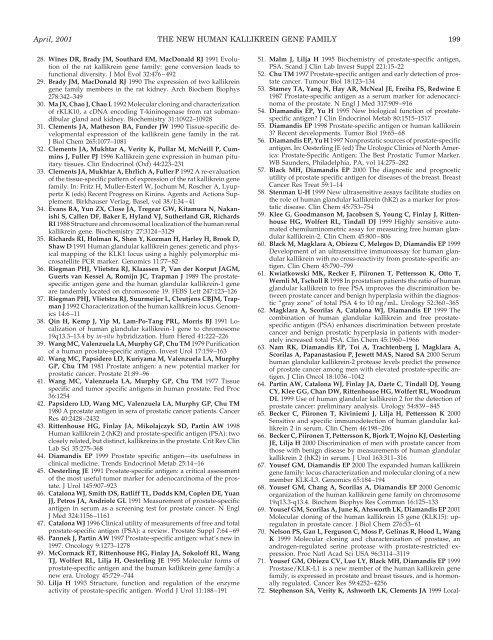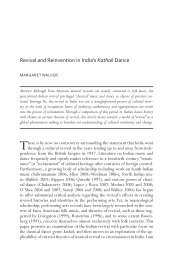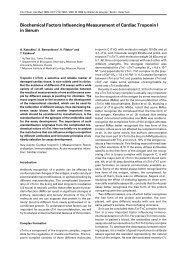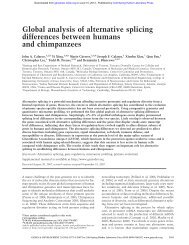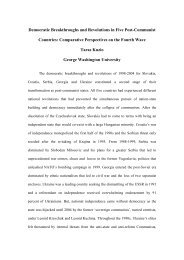The New Human Tissue Kallikrein Gene Family - Endocrine Reviews
The New Human Tissue Kallikrein Gene Family - Endocrine Reviews
The New Human Tissue Kallikrein Gene Family - Endocrine Reviews
Create successful ePaper yourself
Turn your PDF publications into a flip-book with our unique Google optimized e-Paper software.
April, 2001 THE NEW HUMAN KALLIKREIN GENE FAMILY 19928. Wines DR, Brady JM, Southard EM, MacDonald RJ 1991 Evolutionof the rat kallikrein gene family: gene conversion leads tofunctional diversity. J Mol Evol 32:476–49229. Brady JM, MacDonald RJ 1990 <strong>The</strong> expression of two kallikreingene family members in the rat kidney. Arch Biochem Biophys278:342–34930. Ma JX, Chao J, Chao L 1992 Molecular cloning and characterizationof rKLK10, a cDNA encoding T-kininogenase from rat submandibulargland and kidney. Biochemistry 31:10922–1092831. Clements JA, Matheson BA, Funder JW 1990 <strong>Tissue</strong>-specific developmentalexpression of the kallikrein gene family in the rat.J Biol Chem 265:1077–108132. Clements JA, Mukhtar A, Verity K, Pullar M, McNeill P, CumminsJ, Fuller PJ 1996 <strong>Kallikrein</strong> gene expression in human pituitarytissues. Clin Endocrinol (Oxf) 44:223–23133. Clements JA, Mukhtar A, Ehrlich A, Fuller P 1992 A re-evaluationof the tissue-specific pattern of expression of the rat kallikrein genefamily. In: Fritz H, Muller-Esterl W, Jochum M, Roscher A, LyuppertzK (eds) Recent Progress on Kinins. Agents and Actions Supplement.Birkhauser Verlag, Basel, vol 38/I:34–4134. Evans BA, Yun ZX, Close JA, Tregear GW, Kitamura N, NakanishiS, Callen DF, Baker E, Hyland VJ, Sutherland GR, RichardsRI 1988 Structure and chromosomal localization of the human renalkallikrein gene. Biochemistry 27:3124–312935. Richards RI, Holman K, Shen Y, Kozman H, Harley H, Brook D,Shaw D 1991 <strong>Human</strong> glandular kallikrein genes: genetic and physicalmapping of the KLK1 locus using a highly polymorphic microsatellitePCR marker. Genomics 11:77–8236. Riegman PHJ, Vlietstra RJ, Klaassen P, Van der Korput JAGM,Guerts van Kessel A, Romijn JC, Trapman J 1989 <strong>The</strong> prostatespecificantigen gene and the human glandular kallikrein-1 geneare tandemly located on chromosome 19. FEBS Lett 247:123–12637. Riegman PHJ, Vlietstra RJ, Suurmeijer L, Cleutjens CBJM, TrapmanJ 1992 Characterization of the human kallikrein locus. Genomics14:6–1138. Qin H, Kemp J, Yip M, Lam-Po-Tang PRL, Morris BJ 1991 Localizationof human glandular kallikrein-1 gene to chromosome19q13.3–13.4 by in-situ hybridization. Hum Hered 41:222–22639. Wang MC, Valenzuela LA, Murphy GP, Chu TM 1979 Purificationof a human prostate-specific antigen. Invest Urol 17:159–16340. Wang MC, Papsidero LD, Kuriyama M, Valenzuela LA, MurphyGP, Chu TM 1981 Prostate antigen: a new potential marker forprostatic cancer. Prostate 21:89–9641. Wang MC, Valenzuela LA, Murphy GP, Chu TM 1977 <strong>Tissue</strong>specific and tumor specific antigens in human prostate. Fed Proc36:125442. Papsidero LD, Wang MC, Valenzuela LA, Murphy GP, Chu TM1980 A prostate antigen in sera of prostatic cancer patients. CancerRes 40:2428–243243. Rittenhouse HG, Finlay JA, Mikolajczyk SD, Partin AW 1998<strong>Human</strong> kallikrein 2 (hK2) and prostate-specific antigen (PSA): twoclosely related, but distinct, kallikreins in the prostate. Crit Rev ClinLab Sci 35:275–36844. Diamandis EP 1999 Prostate specific antigen—its usefulness inclinical medicine. Trends Endocrinol Metab 25:14–1645. Oesterling JE 1991 Prostate-specific antigen: a critical assessmentof the most useful tumor marker for adenocarcinoma of the prostate.J Urol 145:907–92346. Catalona WJ, Smith DS, Ratliff TL, Dodds KM, Coplen DE, YuanJJ, Petros JA, Andriole GL 1991 Measurement of prostate-specificantigen in serum as a screening test for prostate cancer. N EnglJ Med 324:1156–116147. Catalona WJ 1996 Clinical utility of measurements of free and totalprostate-specific antigen (PSA): a review. Prostate Suppl 7:64–6948. Pannek J, Partin AW 1997 Prostate-specific antigen: what’s new in1997. Oncology 9:1273–127849. McCormack RT, Rittenhouse HG, Finlay JA, Sokoloff RL, WangTJ, Wolfert RL, Lilja H, Oesterling JE 1995 Molecular forms ofprostate-specific antigen and the human kallikrein gene family: anew era. Urology 45:729–74450. Lilja H 1993 Structure, function and regulation of the enzymeactivity of prostate-specific antigen. World J Urol 11:188–19151. Malm J, Lilja H 1995 Biochemistry of prostate-specific antigen,PSA. Scand J Clin Lab Invest Suppl 221:15–2252. Chu TM 1997 Prostate-specific antigen and early detection of prostatecancer. Tumour Biol 18:123–13453. Stamey TA, Yang N, Hay AR, McNeal JE, Freiha FS, Redwine E1987 Prostate-specific antigen as a serum marker for adenocarcinomaof the prostate. N Engl J Med 317:909–91654. Diamandis EP, Yu H 1995 <strong>New</strong> biological function of prostatespecificantigen? J Clin Endocrinol Metab 80:1515–151755. Diamandis EP 1998 Prostate-specific antigen or human kallikrein3? Recent developments. Tumor Biol 19:65–6856. Diamandis EP, Yu H 1997 Nonprostatic sources of prostate-specificantigen. In: Oesterling JE (ed) <strong>The</strong> Urologic Clinics of North America:Prostate-Specific Antigen: <strong>The</strong> Best Prostatic Tumor Marker.WB Saunders, Philadelphia, PA, vol 14:275–28257. Black MH, Diamandis EP 2000 <strong>The</strong> diagnostic and prognosticutility of prostate specific antigen for diseases of the breast. BreastCancer Res Treat 59:1–1458. Stenman U-H 1999 <strong>New</strong> ultrasensitive assays facilitate studies onthe role of human glandular kallikrein (hK2) as a marker for prostaticdisease. Clin Chem 45:753–75459. Klee G, Goodmanson M, Jacobsen S, Young C, Finlay J, RittenhouseHG, Wolfert RL, Tindall DJ 1999 Highly sensitive automatedchemiluminometric assay for measuring free human glandularkallikrein-2. Clin Chem 45:800–80660. Black M, Magklara A, Obiezu C, Melegos D, Diamandis EP 1999Development of an ultrasensitive immunoassay for human glandularkallikrein with no cross-reactivity from prostate-specific antigen.Clin Chem 45:790–79961. Kwiatkowski MK, Recker F, Piironen T, Pettersson K, Otto T,Wernli M, Tscholl R 1998 In prostatism patients the ratio of humanglandular kallikrein to free PSA improves the discrimination betweenprostate cancer and benign hyperplasia within the diagnostic“gray zone” of total PSA 4 to 10 ng/mL. Urology 52:360–36562. Magklara A, Scorilas A, Catalona WJ, Diamandis EP 1999 <strong>The</strong>combination of human glandular kallikrein and free prostatespecificantigen (PSA) enhances discrimination between prostatecancer and benign prostatic hyperplasia in patients with moderatelyincreased total PSA. Clin Chem 45:1960–196663. Nam RK, Diamandis EP, Toi A, Trachtenberg J, Magklara A,Scorilas A, Papanastasiou P, Jewett MAS, Narod SA 2000 Serumhuman glandular kallikrein-2 protease levels predict the presenceof prostate cancer among men with elevated prostate-specific antigen.J Clin Oncol 18:1036–104264. Partin AW, Catalona WJ, Finlay JA, Darte C, Tindall DJ, YoungCY, Klee GG, Chan DW, Rittenhouse HG, Wolfert RL, WoodrumDL 1999 Use of human glandular kallikrein 2 for the detection ofprostate cancer: preliminary analysis. Urology 54:839–84565. Becker C, Piironen T, Kiviniemi J, Lilja H, Pettersson K 2000Sensitive and specific immunodetection of human glandular kallikrein2 in serum. Clin Chem 46:198–20666. Becker C, Piironen T, Pettersson K, Bjork T, Wojno KJ, OesterlingJE, Lilja H 2000 Discrimination of men with prostate cancer fromthose with benign disease by measurements of human glandularkallikrein 2 (hK2) in serum. J Urol 163:311–31667. Yousef GM, Diamandis EP 2000 <strong>The</strong> expanded human kallikreingene family: locus characterization and molecular cloning of a newmember KLK-L3. Genomics 65:184–19468. Yousef GM, Chang A, Scorilas A, Diamandis EP 2000 Genomicorganization of the human kallikrein gene family on chromosome19q13.3-q13.4. Biochem Biophys Res Commun 16:125–13369. Yousef GM, Scorilas A, June K, Ahsworth LK, Diamandis EP 2001Molecular cloning of the human kallikrein 15 gene (KLK15): upregulatonin prostate cancer. J Biol Chem 276:53–6170. Nelson PS, Gan L, Ferguson C, Moss P, Gelinas R, Hood L, WangK 1999 Molecular cloning and characterization of prostase, anandrogen-regulated serine protease with prostate-restricted expression.Proc Natl Acad Sci USA 96:3114–311971. Yousef GM, Obiezu CV, Luo LY, Black MH, Diamandis EP 1999Prostase/KLK-L1 is a new member of the human kallikrein genefamily, is expressed in prostate and breast tissues, and is hormonallyregulated. Cancer Res 59:4252–425672. Stephenson SA, Verity K, Ashworth LK, Clements JA 1999 Local-


